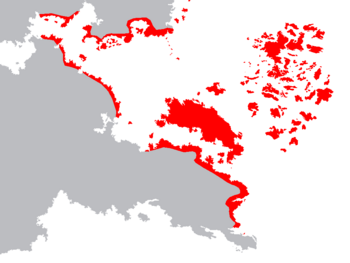Sabrian Empire
This article is incomplete because it is pending further input from participants, or it is a work-in-progress by one author. Please comment on this article's talk page to share your input, comments and questions. Note: To contribute to this article, you may need to seek help from the author(s) of this page. |
Sabrian Empire Impera Sabriana | |
|---|---|
| 803 BCE–858 CE | |
 The Sabrian Empire at its greatest extent in 657 BCE. | |
| Capital | Sabria (modern-day Padova) |
| Common languages | Sabrian |
| Religion | Mos Maiorum |
| Demonym(s) | Sabrian |
| Government | Mercantile oligarchic thalassocracy |
| Legatus | |
• 803 - 744 BCE | Atria Razisnei |
• 813 - 858 CE | Marcus Karantus |
| Historical era | Antiquity |
• Established | 803 BCE |
• Reformed | 858 CE |
| Population | |
• 448 BCE | ~10,000,000 (entire empire) |
| Currency | Siren |
| Today part of | Acrea Cacerta Gylias Knichus Lirinya Quenmin |
Sabria, its wider sphere of influence known as the Sabrian Empire was an ancient Cacertian state that encompassed the Cacertian archipelago, much of the coastline of eastern Siduri, and parts of southeast Eracura. Cacertians founded the city of Sabria in 877 BCE and over the course of seven decades managed to establish political hegemony over other Cacertian settlements throughout the Cacertian islands. For much of Sabria’s history, it was on hostile terms with the expansionist Symmerian Empire which eventually led to a number of successive conflicts known as the Sabrian Wars.
The official agreed upon date of the Sabrian State’s foundation is considered 803 BCE when Atria Razisnei, a princess of Sabria, was voted to be the first Legatus of the Sabrian Senate having commanded Sabrian troops to victory in their conquests of the island of Sarissita. Much of Atria’s tenure as Legatus saw the rapid expansion of Sabrian influence, eventually encompassing the norther half of the Cacertian archipelago. After Atria’s rule ended, her adopted son Mettius Arcadius was voted as Legatus. His rule was short-lived, however, and he later died under mysterious circumstances in 739 BCE. He was succeeded by Hirpinia Modia and it was under her rule that Sabria launched a number of military campaigns that succeeded in further expanding Sabrian rule to include the rest of the Cacertian isles, the island of Lirinya, the coasts of eastern Siduri, and southeast Eracura. After Modia's expansion and excluding a handful of minor conflicts with native peoples in foreign lands, the Sabrians saw several centuries of peace and prosperity brought about by their trade.
At its greatest extent in the mid 600s BCE, Sabria—with its colonies, vassals, and numerous satellite states—was one of the largest and richest polities in Tyran which was a direct result of its vast mercantile network. With its large reach, Sabria was able to trade various lucrative exports of agricultural goods and manufactured products, providing access to materials and technologies that would otherwise have been impossible to find. The growth of Sabria resulted in the Empire’s investment into a large military to secure its commercial interest; this lead to the creation of one of the largest and most powerful navies of ancient Tyran and an army composed of a mix of varying ethnicities which included foreign mercenaries, auxiliaries, and levies.
By the 300s CE, the territory of the Sabrian Empire was being slowly reduced as a result of several conflicts with the rapidly growing Acrean Empire in Eracura. The First and Second Sabrian Wars, fought between 656 and 692 CE, further weakened the Empire. Internal conflict in the 800s CE eventually led to the independence of several of Sabria’s client city-states within the Cacertian Archipelago, reducing the former mercantile state to several holdings in the northeast. In 858 CE, the old Sabrian state was dissolved under Legatus Marcus Karantus who transferred power to the Padova Family who would later go on to found the Padovan Empire.
History
Government and Politics
Military
Language
Economy
Society and Culture
Religion
Sabrians were primarily practitioners of their native religion of Mos Maiorum which possessed a pantheon of four goddesses which were each closely associated with a season of the year. The religion was divided into two primary cults; the Cult of Transformation and the Cult of Preservation. Although there is not an exact hierarchy in Mos Maiorum, it is generally accepted that the most powerful of the four deities were Veturia and Hostilia, the patrons of spring and winter respectively.

